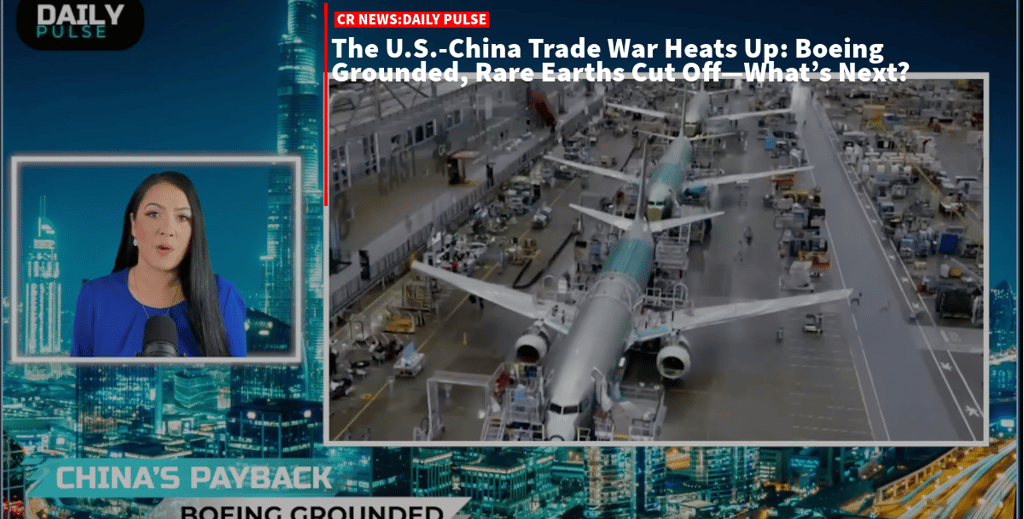The U.S.-China Trade War Heats Up: Boeing Grounded, Rare Earths Cut Off—What’s Next?
4/17/2025


The U.S.-China Trade War Heats Up: Boeing Grounded, Rare Earths Cut Off—What’s Next?
The U.S.-China trade war just took a dramatic turn, and the stakes couldn’t be higher. On April 16, 2025, The Vigilant Fox reported a bombshell: China has grounded all Boeing jets and banned U.S. aircraft parts in retaliation for President Trump’s hefty 145% tariffs on Chinese goods. But that’s not all—China also slashed exports of six critical rare earth minerals, the lifeblood of everything from drones to semiconductors. With tensions escalating, this tit-for-tat could spark a full-scale trade war, threatening global economies and reshaping industries. Buckle up—this is a story you won’t want to miss.
A Retaliatory Strike with Global Ripples
China’s move is a direct response to Trump’s tariffs, which have already hit Chinese imports like electric vehicles and syringes with rates as high as 245%, according to trending posts on X. Beijing’s decision to halt Boeing deliveries and U.S. parts purchases is a gut punch to the American aviation giant, already reeling from past challenges like the 737 MAX crashes in 2018 and 2019. Reuters reported on April 16, 2025, that China’s top airlines—Air China, China Eastern, and China Southern—had planned to take 45, 53, and 81 Boeing planes respectively through 2027. Now, those deliveries are in limbo, and Boeing’s shares have shed over a third of their value since last year’s mid-air door panel blowout on a MAX 9 jet.
But the real kicker? China’s cutoff of rare earth minerals. These elements are essential for tech, defense, and green energy sectors, and China controls 90% of the global supply, as noted in a Reuters article from April 4, 2025. The U.S. has only one rare earth mine and relies heavily on Chinese imports. This move could cripple American manufacturing, from missiles to electric vehicles, forcing companies to scramble for alternatives in a market with few options.
The Bigger Picture: A Trade War on Steroids
This isn’t just about Boeing or minerals—it’s a glimpse into a broader economic showdown. The U.S. and China together make up 43% of the global economy, and their trade relationship, valued at over $650 billion in 2024, is teetering on the edge. The Vigilant Fox highlighted the risk of inflation as import costs rise, potentially slashing consumer spending and slowing business investment. The World Trade Organization warned on April 9, 2025, that bilateral trade between the two giants could shrink by 80% if tensions keep escalating.
X users are buzzing with reactions. @YairTheLight argues this proves the U.S. needs to bring essential manufacturing home, while @Gee_Unit123 points out that China relies on the U.S. for 60% of its soybeans—a $15 billion market—suggesting America has leverage too. Others, like @GenXJoJo, see a silver lining, noting Boeing’s recent track record of issues might make this a “win” for safety.
What’s at Stake—and Who Wins?
The fallout could be seismic. For the U.S., higher costs and supply chain disruptions might fuel inflation, already projected to climb above 4% this year, per Al Jazeera on April 11, 2025. Jobs are on the line too—the U.S.-China Business Council estimated 245,000 jobs were lost during Trump’s first trade war in 2018, and with broader tariffs now, that number could grow. On the flip side, China risks losing access to key U.S. exports like soybeans and tech, which could hurt its economy.
Globally, the impact is already being felt. The trade war has slowed economic growth worldwide, with the IMF cutting its 2019 global growth forecast to 3.3% amid similar tensions, according to Wikipedia. Countries like Germany and Canada are feeling the pinch, while some nations might benefit by filling manufacturing gaps left by the U.S.-China rift.
The Road Ahead: A New Economic Order?
As both nations dig in, the question looms: where does this end? China is reportedly reaching out to allies like Europe and Japan to counter Trump’s tariffs, per Reuters on April 14, 2025. Meanwhile, Trump’s “instinct-driven” tariff strategy—pausing levies on 60 countries but keeping a 125% rate on China—has markets on edge, despite a recent S&P 500 surge of 9.5%, the biggest since 2008.
This clash could force the U.S. to rethink its supply chains, potentially spurring domestic mining and manufacturing. Companies like Phoenix Tailings are already ramping up rare earth recycling, aiming to produce 4,000 metric tons by 2027. But in the short term, the pain will be real—both for American industries and consumers facing higher prices.
What Do You Think?
This trade war is far from over, and its consequences will shape the global economy for years. What’s your take—will the U.S. and China find a way to de-escalate, or are we headed for a deeper divide? How should the U.S. respond to China’s rare earth leverage? And could this be the push America needs to rebuild its manufacturing base? Share your thoughts—I’d love to hear them.
hello@boncopia.com
+13286036419
© 2025. All rights reserved.